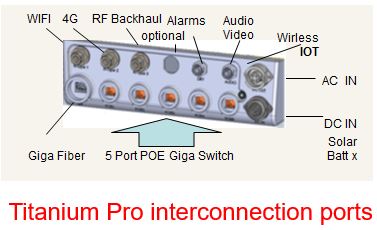דור חדש של מערכות חשמל ותקשורת לניהול ערים SMART CITY
The Latest Trend of Turning a Regular City into a Smart City
The latest trend of transforming a regular city into a smart city enhances the services provided by the municipality to its residents, simplifies the municipality's control over its resources, city management, service delivery to residents, as well as infrastructure for electricity, communication, security, water, sewage, irrigation, transportation, and more.
Upgrading a city to be smart is possible through the establishment of intelligent control centers in cities and the deployment of communication equipment, security cameras, and IoT devices throughout the city, all connected to the control center in the municipality.
The electronic equipment deployed throughout the city in smart city projects is often installed on streetlight poles, bus and train stations, and public buildings. It requires a reliable and consistent power supply and communication infrastructures that provide electricity and communication for cameras and IoT devices.
Titanium, the new power and communication product line from Advice for smart cities, is designed to meet these needs. It includes outdoor power and communication systems intended to enable the installation and operation of this equipment throughout the cities. The power systems are designed to stabilize the electrical network voltage, convert it into direct current for outdoor equipment, and ensure stable electricity supply 24 hours a day, 7 days a week.
There are three types of systems to handle most of the required installations:
- UPS Systems - Stabilize the network voltage supplied to the equipment and ensure proper power supply even during short power outages.
- Street Light Systems - These systems are powered by street lighting that operates only at night. They charge for about 6 hours during the night and supply power to the equipment from batteries for about 16 hours of daylight.
- Solar Systems - Installed in locations without access to the power grid, they charge for an average of 6 hours of sunlight and supply the load from batteries for about 18 hours when solar energy is insufficient to power the equipment.
Titanium is based on a combination of a new generation of solid power supplies and advanced lithium batteries designed to operate in outdoor conditions. It significantly upgrades power systems from previous generations that suffered from excessive weight, size, and frequent battery replacements.
Titanium reduces the size and weight of the cabinets; its slim design blends with the width of the pole on which it is mounted. The systems are lightweight and smaller than 60% of regular systems, do not require ventilation, and do not rust due to their aluminum housing.
The device communicates with the control center and reports on faulty power networks or drained batteries, providing feedback on the remaining charge before battery replacement is needed and the required charging time.
A breakthrough brought by the lithium batteries in Titanium is their ability to charge and discharge 1,500-2,000 times, ensuring regular operation for 3-5 years without needing battery replacement. The batteries are environmentally friendly and allow monitoring of more than 15 battery parameters remotely. The system provides direct voltage of 12/24/48 volts for smart city and safe city systems.
Titanium Pro, the second family of products introduced by Advice, serves as a communication hub for equipment installed on the pole and includes an internal UPS to ensure a steady power supply for the devices mounted on the pole.
Titanium Pro includes a 5-port gigabit POE switch for fast image transmission from megapixel cameras and for connecting wireless equipment mounted on the pole to the internet, along with an optical uplink port for quick access to remote hubs. The managed switch operates at layer 3, providing power through innovative POE at voltages of 12/24/48 volts and power outputs of 15/30/60 watts. Each port can be programmed for the required voltage and power by any device, maximizing the use of the power system.
In addition to the optical access option, the system has three SNA connectors for connecting various types of antennas required by wireless equipment. Wireless backhaul of the NLOS type can be installed, allowing wireless access at speeds of up to 750 Mbps without the need for a line of sight between antennas and over distances of several kilometers, while WIFI can be configured as a bridge for distances of several kilometers or cellular 4G communication based on an internal SIM that determines which cellular provider to use.
Additional wireless options include a WIFI access point allowing free WIFI browsing throughout the city, G4 for cellular phones, and Zigbee, Alora, Bluetooth, and others for monitoring IoT devices.
Titanium Pro also has impressive audio/video capabilities, allowing the municipality to conduct outdoor advertising through street screens connected to the system via a DVI interface, activate paging systems through an internal CODEK interface, and connect a microphone for noise control and security.
The system is suitable for traffic and security monitoring applications using an optional internal PC104 or RUSBERY running ANALYTICS or LPR software. OEMs can also install specific image processing or communication software for the cabinet. An internal installation surface is suitable for the internal installation of customer equipment and adapting the system for special and specific applications.
Titanium Pro is designed for security applications including intrusion and violence detection, noise monitoring, radiation, toxic gases, fire, and earthquakes, monitoring water, electricity, and gas meters, 4G communication, free WIFI for residents, advertising, paging, parking and traffic congestion control, garbage collection, water and sewage management, and irrigation management.
The system, which is a technological breakthrough of global standards, is offered in an IP67 sealed aluminum housing that connects to the outside world through waterproof and dustproof connectors and includes equipment for easy and quick installation on poles.
Integrators and OEMs can adapt it to almost any tender or requirement without needing to build a dedicated communication cabinet from parts.


{formbuilder:5448}



 תפריט נגישות
תפריט נגישות







